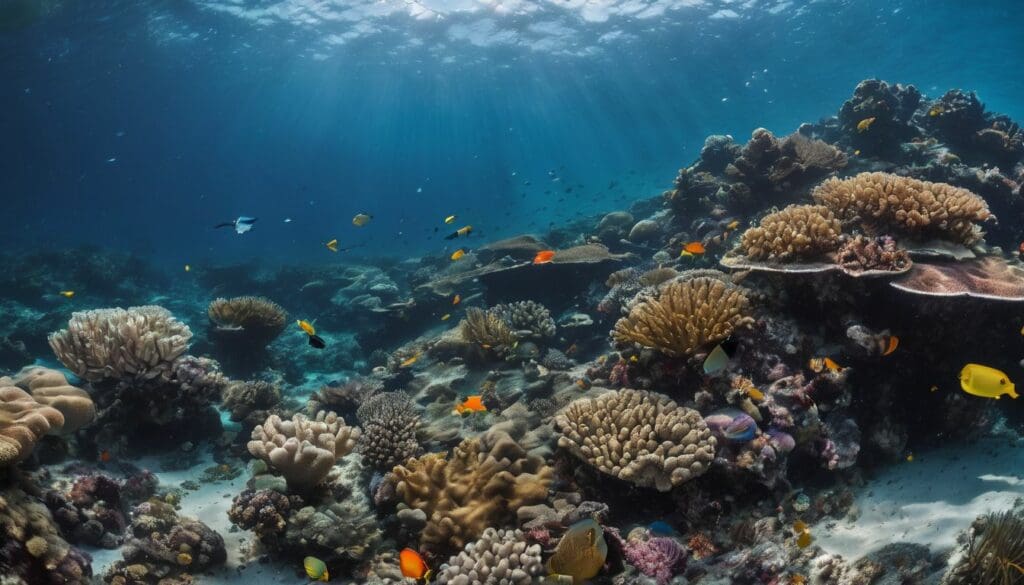Picture this: our beautiful beaches and majestic oceans harbouring unseen adversaries amidst their grains and waves. Like many of us, I’m tremendously concerned about these diminutive interlopers—microplastics.
Alarmingly, research indicates a mammoth 8 million metric tonnes of them are making their way into our seas annually. In the article we’re crafting, we’ll delve into the odyssey of these microplastics from oceanic abysses to the very plates from which we dine, exploring the implications for humanity and marine life alike.
Let us embark on an enlightening expedition together – it’s high time we brought clarity to our waters.
Key Takeaways
- Microplastics, both primary and secondary types, enter our oceans at a staggering rate of 8 million metric tonnes per year; they originate from everyday products like exfoliating cosmetics, synthetic textiles, and increase due to COVID-19 related single-use plastics.
- These minuscule particles pose dire consequences for marine ecosystems by causing harm to wildlife through ingestion and for humans potentially through food sources like seafood where they can accumulate toxic substances.
- Solutions to combat this growing issue include adopting innovative technologies for microplastic removal, enforcing stricter regulations on plastic production and disposal, promoting sustainable consumer behaviour and increasing awareness about the risks associated with microplastics.
Understanding Microplastics
Microplastics come in two forms: primary, which are intentionally manufactured small plastic particles, and secondary, which are the result of larger plastic debris breaking down over time.
The sources of microplastics range from industrial plastic products to synthetic textiles, with COVID-19 exacerbating the issue due to increased use of single-use plastics and personal protective equipment.
Primary and secondary microplastics
As we delve into the realm of microplastics, it’s crucial to distinguish between two main types: primary and secondary. Primary microplastics are tiny particles designed for commercial use, like in cosmetics or industrial scrubbers.
Imagine these as tiny plastic beads that start small and are used in products we encounter daily without even realising their presence.
Now let’s talk about secondary microplastics. These arise from larger items breaking down over time—think about plastic bottles and bags worn away by sun, wind, and water. Their deterioration eventually turns them into minuscule fragments that can be hard to see with the naked eye but can have a profound impact on marine life and ecosystems.
As passionate gamers who understand how small elements can affect an entire game environment, consider how these seemingly insignificant pieces pose a challenge to our oceans’ health and ultimately our own well-being when they enter the food chain through aquatic lives threatened by this synthetic menace.
Sources of microplastics
Microplastics originate from a variety of sources and are divided into primary and secondary microplastics. Primary microplastics come directly from various industrial and commercial products, such as personal care products like exfoliating beads and synthetic clothing fibers. On the other hand, secondary microplastics are formed from the degradation of larger plastic items like bottles and bags, as well as industrial processes. The impact of COVID-19 has exacerbated the issue with an increase in single-use plastics, contributing to the contamination of waterways and marine environments. Additionally, tire wear from roads has been identified as a significant source of microplastic pollution in aquatic ecosystems.
- Microfibers released during washing of synthetic textiles
- Breakdown of plastic waste in landfills and oceans
- Urban runoff carrying plastic particles into water bodies
- Disintegration of fishing gear and aquaculture equipment
- Atmospheric deposition of microplastics through wind and air currents
Impact of COVID-19 on microplastic pollution
The global pandemic has significantly impacted the production and use of single-use plastics, exacerbating microplastic pollution. With an increased demand for personal protective equipment (PPE) such as face masks, gloves, and plastic shields, there has been a surge in plastic waste entering our environment.
In addition to this, restrictions on reusable items like bags and containers have led to a rise in disposable plastic usage. Consequently, improper disposal of these items further contributes to the proliferation of microplastics in both terrestrial and marine ecosystems.
Furthermore, the temporary closure of recycling facilities and reduction in waste management infrastructure during lockdowns have hindered proper waste disposal practices. This has led to an accumulation of plastic debris that eventually breaks down into smaller particles – adding to the microplastic load in various environments.
The Far-Reaching Effects of Microplastics
Microplastics have a detrimental impact on marine ecosystems and wildlife, with effects ranging from entanglement to ingestion. These tiny plastic particles also pose a significant threat to human health, as they can accumulate toxic chemicals and enter the food chain.
On marine ecosystems and wildlife
Plastic pollution in the ocean poses a significant threat to marine ecosystems, biodiversity, and the food web. Microplastics have been found in various marine environments, posing a threat to marine life and the food chain.
The ingestion of microplastics by marine organisms can lead to choking and starvation, impacting the delicate balance of our oceans. Additionally, plastic waste in the marine environment poses a danger of being swallowed by marine life, leading to severe consequences for their health and survival.
The threat of microplastics to the ocean and planet is a significant global issue that needs urgent attention from all sectors. Taking into account its wide-reaching effects on wildlife and entire ecosystems, addressing this menace should be at the forefront of conservation efforts worldwide.
It’s vital that we take decisive action to protect our precious oceans and safeguard the diverse array of species that call them home.
On human health
Moving from the impact of microplastics on marine ecosystems and wildlife, it is crucial to recognise the potential threat to human health. Microplastics pose a significant risk to human health as they contaminate the food chain, with seafood being particularly vulnerable.
The ingestion of microplastics through food consumption has raised concerns about potential dangers to human well-being, necessitating urgent attention and action. This invisible menace not only threatens marine life but also poses an insidious danger to our own health, making it imperative for us to address this global issue.
Furthermore, there is growing evidence that the presence of microplastics in our environment can have adverse effects on human health. As these minuscule particles infiltrate various aspects of our lives, from what we eat to the water we drink, their impact on our well-being cannot be ignored.
Routes of Exposure to Microplastics
Ingestion, inhalation, and dermal contact are the three primary routes through which humans are exposed to microplastics. These tiny plastic particles can enter our bodies through various means, posing potential risks to human health.
Ingestion
Microplastics are a hidden threat that can be ingested through the food we consume, especially seafood. These tiny plastic particles pose a risk to human health as they contaminate the food chain and may result in potential harm.
The ingestion of microplastics by marine creatures can lead to choking and starvation, adversely impacting marine life and ultimately threatening our own well-being.
Marine organisms consuming microplastics also face risks from plastic waste that contaminates their environment. This contamination presents a significant danger to marine ecosystems, biodiversity, and the intricate balance of the food web.
Inhalation
When considering the routes of exposure to microplastics, it’s crucial to recognise that inhalation is another concerning pathway. Airborne microplastics, primarily originating from synthetic fibre shedding, industrial processes, and atmospheric deposition, pose a risk of being inhaled by humans and animals.
These tiny particles can penetrate deep into the respiratory system upon inhalation, potentially leading to adverse health effects such as inflammation and respiratory issues. The presence of microplastics in the air we breathe emphasises the far-reaching impact of this environmental contamination on both terrestrial and marine ecosystems.
Inhalation presents an often-overlooked avenue through which microplastics can enter our bodies and the environment. As we continue to address the hidden menace posed by these minuscule plastics, understanding the potential inhalation risks is essential for developing comprehensive strategies to mitigate their impact on human health and ecological systems.
Dermal contact
In addition to ingestion and inhalation, dermal contact is another route of exposure to microplastics. When our skin comes into direct contact with items or surfaces containing microplastics, there is potential for these tiny particles to be absorbed into our bodies.
This can occur through everyday activities such as using personal care products containing microbeads or handling materials made from synthetic fibers like polyester. Studies have shown that microplastic particles can penetrate the skin and enter the bloodstream, raising concerns about the possible health effects of dermal exposure to these pervasive pollutants.
Microplastics found in various personal care products and fabrics can potentially transfer onto our skin, posing a hidden threat that adds another dimension to the complex issue of plastic pollution.
Addressing the Microplastic Problem
Government and industry actions, innovative solutions and technologies, and individual consumer role and awareness are crucial in combatting the microplastic problem. Join us as we delve deeper into how we can all play a part in addressing this hidden threat.
Government and industry actions
To address the microplastic problem, government and industry are taking significant actions:
- Enforcing regulations to limit plastic production and encourage sustainable alternatives, mitigating further microplastic pollution.
- Investing in research and development to innovate new technologies for efficient microplastic removal and better waste management systems.
- Collaborating with international organisations to establish global standards for reducing microplastics in consumer products and industrial processes.
- Encouraging corporate responsibility by implementing extended producer responsibility laws to hold industries accountable for their plastic waste generation.
- Supporting initiatives that promote recycling and circular economy models, promoting a more sustainable approach to plastic use and disposal.
- Empowering public – private partnerships to fund projects aimed at cleaning up existing microplastics from oceans and water bodies.
- Educating consumers through awareness campaigns about the impacts of plastic pollution, fostering behavioural changes in purchasing habits and lifestyle choices.
Innovative solutions and technologies
Innovative solutions and technologies are being developed to combat the menace of microplastics to our oceans and planet. These advancements aim to reduce plastic pollution and minimise the impact on marine ecosystems and human health.
- Advanced filtration systems utilising nanotechnology can efficiently capture microplastics from wastewater before they reach water bodies, preventing contamination of the environment and aquatic life.
- Biodegradable polymers are being engineered as sustainable alternatives to traditional plastics, reducing the accumulation of non-degradable materials in the environment.
- In – situ remediation techniques such as using specialised microorganisms or enzymes offer promising solutions for breaking down microplastics in natural habitats, mitigating their harmful effects on ecosystems.
- Innovative ocean cleanup technologies, including autonomous drones equipped with collection systems, enable efficient removal of floating plastic debris from marine environments, contributing to cleaner oceans.
- Development of eco – friendly materials for packaging and consumer products reduces reliance on conventional plastics, minimising the entry of microplastics into the environment through various sources.
- 3D printing technology is being harnessed to create biodegradable products without compromising performance or durability, offering sustainable options that limit environmental degradation due to plastic waste.
- Adoption of blockchain technology allows for transparent tracking of plastic waste throughout its lifecycle, facilitating better waste management practices and promoting accountability across supply chains.
Individual consumer role and awareness
As we consider the impact of microplastics on marine ecosystems and human health, it’s crucial for individual consumers to understand their role in addressing this widespread issue.
By making informed choices about our purchasing habits, such as favouring products with minimal plastic packaging or opting for reusable alternatives, we can significantly reduce our contribution to the problem.
Additionally, being mindful of proper waste disposal and recycling practices can help prevent further contamination of our environment with microplastics. Increasing awareness through education and advocacy within our communities is also vital for fostering a collective understanding of the threat posed by microplastics and promoting sustainable consumer behaviour.
Global Efforts and Future Directions
Creating a movement for change involves raising awareness, advocating for policy changes, and supporting innovative solutions. However, there is still a significant gap between policy practices and actual implementation, highlighting the need for more effective global cooperation and future research directions.
Creating a movement for change
Focusing on the issue of microplastics can encourage policy changes and innovation. We can join forces with environmental organisations to advocate for stricter regulations on plastic use and disposal.
By voicing our concerns, we contribute to a growing movement for change, influencing policymakers and industries to prioritise sustainable practices.
Educating ourselves about microplastics and sharing this knowledge with others is crucial in creating a widespread understanding of the issue. Through social media campaigns, awareness events, and educational initiatives, we can inspire more individuals to take action against plastic pollution and demand accountability from manufacturers.
Policy practice gap
Government policies and regulations play a crucial role in addressing the microplastic problem. However, there exists a significant policy practice gap that hinders effective implementation of measures to curb microplastic pollution.
This gap can be observed in insufficient enforcement of regulations, lack of coordination between government bodies, and inadequate funding for research and initiatives aimed at tackling microplastics.
Furthermore, the absence of standardised monitoring methods and assessments contributes to this disparity, making it challenging to measure the effectiveness of existing policies.
As passionate gamers and novice gamers interested in environmental issues like microplastic pollution, understanding the policy practice gap is essential as it highlights the need for stronger governmental action and accountability.
By bridging this gap through increased collaboration between policymakers, scientists, industry stakeholders, and public awareness campaigns, we can work towards more robust strategies to combat microplastic contamination effectively.
Future research directions
Moving forward, the identification and quantification of microplastics in different environmental compartments require extensive research. Investigating the long-term effects of microplastic exposure on human health, especially regarding ingestion through seafood consumption, is crucial.
Furthermore, understanding the degradation pathways and persistence of microplastics in marine ecosystems can guide future mitigation strategies. Research into innovative technologies that effectively capture and remove microplastics from aquatic environments is essential for combatting this global issue.
Additionally, exploring the impact of climate change on the distribution and behavior of microplastics will provide invaluable insights into developing proactive measures to mitigate their detrimental effects.
Continuing our focus on raising awareness about this pervasive threat among various stakeholders and enhancing interdisciplinary cooperation will also be a significant area for future research.
Conclusion
In conclusion, we must urgently address the microplastic menace threatening our oceans and food chain. Taking immediate action is crucial to protecting marine life and human health from this hidden threat.
Governments, industries, and individuals need to collaborate in implementing solutions to mitigate the impact of microplastics on our planet. It’s imperative that we raise awareness about this issue and drive positive changes for a cleaner, healthier environment for all.
FAQs
1. What are microplastics and why are they a menace?
Microplastics are tiny plastic particles that come from larger plastics breaking down. They pose a serious menace as they lead to water pollution, ocean contamination, and eventually end up in our food.
2. How do microplastics affect the environment?
The environmental impact of microplastics is significant; they contribute to aquatic pollution, harm marine life, and play a role in climate change effects due to their persistence in ecosystems.
3. Can we prevent microfiber pollution and control plastic degradation?
Yes, we can tackle microfiber pollution through better waste management practices and using materials that don’t degrade into harmful plastics, which helps control overall plastic contamination.
4. Are there measures being taken for pollution control concerning microplastics?
Efforts like enhancing water treatment processes, pushing for stricter regulations on manufacturing industries to reduce emissions of plastics into oceans, and raising public awareness help with the environmental impact mitigation of this hidden threat.





